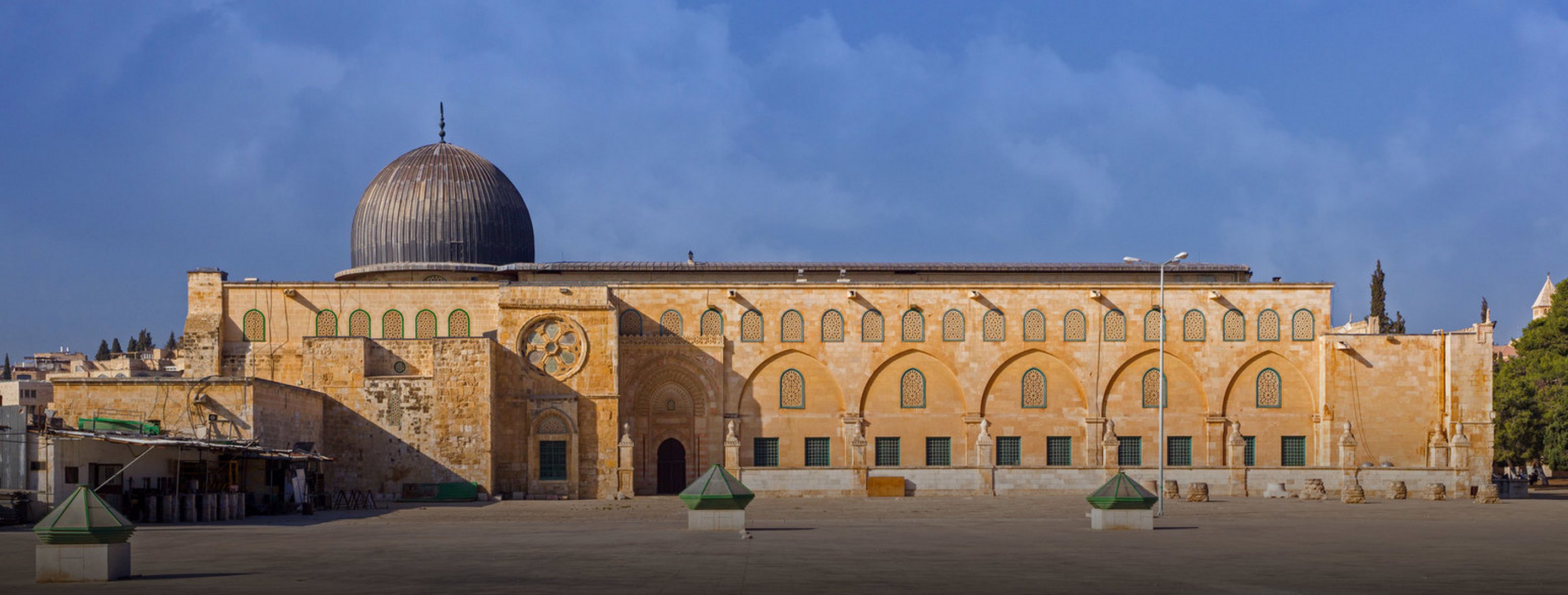Description
Property Name: Al-Qibly Mosque, Al-Masjid Al-Qibly (in Al-Aqsa Mosque, Al-Masjid Al-Aqsa)
Inventory No: 972-2-2
Date of infill of the inventory form: 2007-09-19
Country (State party): Palestine
Province : Al Quds/Jerusalem
Town: Old town
Geographic coordinates: 31° 46′ 34.19″ N
35° 14′ 7.75″ E
Historic Period: Umayyad
Year of Construction: 705 – 714 AD
Style: Early Islamic
Original Use: Mosque
Current Use: Mosque
Architect: Unknown
Significance
Within its existence is related to the night journey of the Prophet Muhammad’s (Sallallahu Alayhi Wa Sallam) from Mecca to Jerusalem and his ascent to Heaven, the mosque, after than Mecca and Medina, is considered as the holiest place of prayer in the Muslim world. It is one of the most significant buildings constructed in the Early Muslim Period as well as being the earliest in Palestine. Al-Aqsa is also one of the largest and most important mosques in the Muslim world.
Selection Criteria
iii. to bear a unique or at least exceptional testimony to a cultural tradition or to a civilization which is living or which has disappeared
iv. to be an outstanding example of a type of building, architectural or technological ensemble or landscape which illustrates (a) significant stage(s) in human history
vi. to be directly or tangibly associated with events or living traditions, with ideas, or with beliefs, with artistic and literary works of outstanding universal significance
State of Preservation
The monument had gone under many restorations throughout its history. When Salah al-Din liberated the city of Jerusalem, he restored the mosque in 538 AH / 1187 CE, and it was restored in several later ages such as the Mamluk and Ottoman eras and at the beginning of the British occupation. The first scientific restoration had taken place in 1922 by the Al-Aqsa Mosque and the Dome of the Rock Restoration Committee. Although the original elements of the mosque have been conserved, concrete elements had been introduced during this restoration. Introduction of concrete elements had continued throughout following restorations.
After the fall of Jerusalem under the Zionist occupation, the mosque was exposed to hundreds of attacks, the worst fire in 1389 AH / 21 August 1969 was the worst. The Mihrab of Nur ad-Din Zangi was burnt, and the fire extended to cover most of the three eastern porticos of it, and also to its wooden ceiling. Restoration works had taken place in 1983.The building is daily taken care of by the Waqf and the decorations are being conserved, however it has seen that concrete construction is being introduced to the roof structure. The excavation carried out by the Zionist occupation threatens its foundations, as it extends under most of the southern wall of the Mosque and under the foundations of the entire Al-Qibli mosque.
The last restoration of the monument was in 2016. The Islamic Waqf and The affairs of Al-Aqsa Mosque and the Council of Jerusalem Awqaf supervised the completion of historic projects from the Hashemite Reconstruction of the Al- Aqsa Mosque / the Holy Haram. The project is the restoration of the mosaic of the dome of Al Qibli mosque / Al-Aqsa Mosque, which was implemented since the beginning of the year 2014 and was completed in October 2016 AD – Muharram 1438 AH.
References
ed. Auld, Sylvia and Hillenbrand, Robert; arch. survey by Yusuf Natsheh. Ottoman Jerusalem: the living city: 1517-1917. London: Altajir World of Islam Trust, 2000.
Al-Quds, A Historical Document. Organization of the Islamic Conference.
Bahat, Dan. Carta’s Historical Atlas of Jerusalem, 1983
Burgoyne, Michael H. 1976. A Chronological Index to the Muslim Monuments of Jerusalem. In The Architecture of Islamic Jerusalem. Jerusalem: The British School of Archaeology in Jerusalem.
Burgoyne, Michael Hamilton. Mamluk Jerusalem, an architectural study. Scorpion Publishing Ltd., Essex, England 1987
Creswell, K.A.C. A Short Account of Early Muslim Architecture. Penguin Books, Harmondswoth, 1958.
Duncan, Alistair, The Noble sanctuary: portrait of a holy place in Arab Jerusalem. London: Longman, 1972.
Elad, Amikam. Medieval Jerusalem and Islamic Holy Places, Ceremonies, Pilgrimage. |Brill Leiden, Netherlands, 1995.
Grabar, Oleg. Jerusalem, Constructing the Study of Islamic Art, Volume IV. Ashgate Publishing Company, Hampshire, 2005.
Grabar, Oleg. The Dome of the Rock. Thames and Hudson Ltd., London, 1996.
Ed. Hattstein, Markus, Delius. Peter. Islam Art and Architecture. Könemann Verlagsgesellshaft mbH, France, 2000.
Kroyanker, David. Jerusalem Architecture. Tauris Parke Books, London, 1994.
Najm, Raip Yusuf, The Treasures of Jerusalem. Arabic Cities Organization, Al-Beti Establishment, 1983.
Osman, Colin. Jerusalem Caught in Time. The American University in Cairo Press.1999.
Sha’th, Shawqi. Al-Quds Al-Shareef. ISESCO, Rabat,1995.
Wilson, Colonel Sir Charles W. Jerusalem, The Holy City. Ariel Publishing House, Jerusalem.
Flood, F.B. 1997. “Umayyad Survivals and Mamluk Revivals: Qalawunid Architecture and the Great Mosque of Damascus.” In Muqarnas XIV: An Annual on the Visual Culture of the Islamic World. Gülru Necipoglu (ed). Leiden: E.J. Brill
Grabar, Oleg. The Haram al-Sharif: An Essay in Interpretation, BRIIFS vol.2 no.2 Autumn 2000.
Grafman, Rafi and Myriam Rosen-Ayalon. 1999. “The Two Great Syrian Umayyad Mosques: Jerusalem and Damascus”. Muqarnas: An Annual on the Visual Culture of the Islamic World, XVI
Leisten, Thomas, 1996. “Mashhad al-Nasr: Monuments of War and Victory in Medieval Islamic Art” Muqarnas: An Annual on the Visual Culture of the Islamic World, XIII
Rosen-Ayalon, Myrian. 1989. “The Early Islamic Monuments of Al-Haram al-Sharif: An Iconographic study”. Jerusalem: Qedem.
Serageldin, Ismaïl(ed.). “The Restoration of the Al-Aqsa Mosque”. Space for Freedom. 1989, London: Butterworth Architecture.
Vernoit, Stephen. 1997. “The Rise of Islamic Archaeology.” Muqarnas XIV: An Annual on the Visual Culture of the Islamic World. Gülru Necipoglu (ed). Leiden: E.J. Brill
Yavuz, Yildirim. 1996. The Restoration Project of the Masjid al-Aqsa by Mimar Kemalettin (1922-26). Muqarnas Volume XIII: An Annual on the Visual Culture of the Islamic World. Gülru Necipoglu (ed.). Leiden: E.J. Brill.
UNESCO, (1995) General Conference Twenty-eighth Session Report


